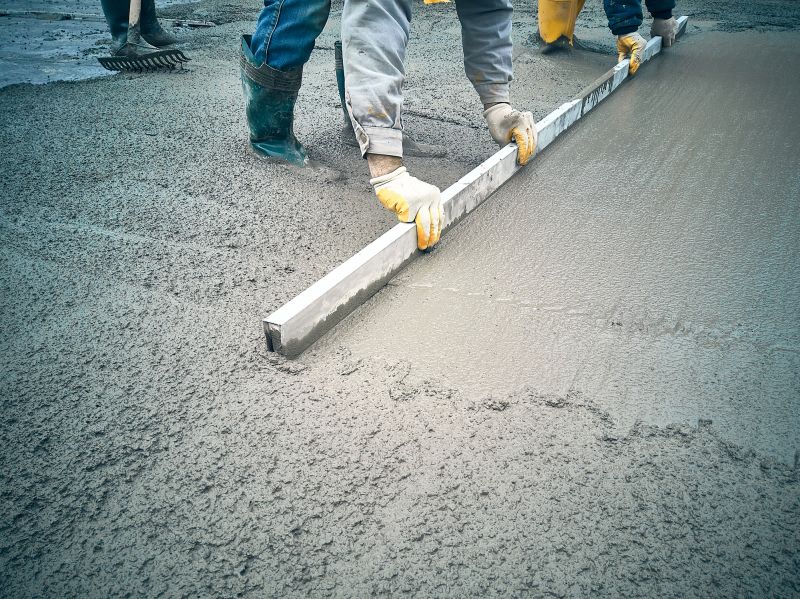Popular Slab Pouring Products Every Contractor Needs in Their Toolbox
Discover the most reliable and durable products that streamline your slab pouring process and improve project outcomes.
 Pouring a concrete slab requires careful preparation and the right set of products to ensure a durable and level surface. From formwork to curing supplies, the tools and materials used in slab pouring play a crucial role in achieving professional results. Selecting appropriate products can help manage the flow of concrete, prevent leaks, and facilitate a smooth finishing process. Whether you are undertaking a small patio project or a large foundation, understanding the available products can streamline your workflow and improve the overall quality of the pour.
Pouring a concrete slab requires careful preparation and the right set of products to ensure a durable and level surface. From formwork to curing supplies, the tools and materials used in slab pouring play a crucial role in achieving professional results. Selecting appropriate products can help manage the flow of concrete, prevent leaks, and facilitate a smooth finishing process. Whether you are undertaking a small patio project or a large foundation, understanding the available products can streamline your workflow and improve the overall quality of the pour.
Top Overall Option
Concrete Formwork System
A versatile concrete formwork system provides a reliable framework for shaping slabs with precision. These systems typically include reusable panels, supports, and accessories that facilitate quick setup and removal, making them suitable for various project sizes. Their durability and ease of use make them a popular choice among DIY enthusiasts and professionals alike, helping to achieve consistent results while reducing waste and labor time.
Types of Products For Slab Pourings
Formwork Panels
Reusable or disposable panels used to shape the edges of the slab and contain the concrete during pouring.
Form Release Agents
Chemicals applied to form surfaces to prevent concrete from sticking, ensuring clean removal and smooth edges.
Concrete Mixers
Equipment used to thoroughly combine concrete ingredients to achieve a uniform mixture before pouring.
Vibrators
Tools that help remove air pockets and consolidate the concrete for a dense, durable slab.
Trowels and Floats
Hand tools used to smooth and finish the surface of the poured slab for a polished look.
Curing Compounds
Sprays or liquids applied to retain moisture and promote proper curing of the concrete.
Curing Blankets
Insulating covers that help maintain moisture and temperature during the curing process.
Leveling Tools
Devices like screeds and laser levels used to ensure the slab is even and at the correct grade.
Support Supports
Supports and braces that hold formwork in place during the pour to maintain shape and stability.
Edge Guides
Tools that help create straight, clean edges along the perimeter of the slab.
Expansion Joints
Pre-formed joints inserted into the slab to control cracking caused by expansion and contraction.
Waterproofing Membranes
Materials applied to the slab surface to prevent water infiltration and damage over time.
Concrete Pumps
Equipment that delivers the concrete mixture directly to the pour site, especially useful for large or hard-to-reach areas.
Finishing Brooms
Tools used to add texture or slip resistance to the surface of the slab after finishing.
Popular Choices
Widely used to ensure proper compaction and reduce air pockets during pouring.
Commonly selected for shaping slabs with clean, defined edges.
Popular for maintaining moisture levels during curing, especially in variable climates.
Frequently chosen to protect slabs from water ingress and damage.
Essential for achieving an even surface and consistent slab thickness.
Commonly used to facilitate easy removal of formwork and achieve smooth edges.
Often incorporated to manage cracking in larger slabs.
Popular for stabilizing formwork during the pour process.
Widely used for mixing ingredients on-site for small to medium projects.
Commonly selected for achieving smooth, flat surfaces after pouring.
Often used to apply curing compounds or moisture during curing.
The process typically begins with setting up formwork, which defines the shape and size of the slab. Proper form release agents and form panels are essential to create clean edges and ease the removal process once the concrete has set. During pouring, tools such as concrete mixers, vibrators, and spreaders help in achieving uniform distribution and minimizing air pockets. After pouring, curing compounds and blankets are used to maintain optimal moisture levels, ensuring proper hydration and strength development.
Investing in high-quality products tailored for slab pouring can also reduce the risk of common issues like cracking, uneven surfaces, or structural weaknesses. It is important to consider the specific requirements of your project, including size, load-bearing needs, and environmental conditions, when choosing your supplies. Proper planning and the right products can make the difference between a successful pour and a problematic outcome, ultimately saving time and resources in the long run.
Key Buying Considerations
- Project size and scope to determine the quantity and type of products needed.
- Compatibility of formwork systems with the size and shape of the slab.
- Ease of use and setup time for tools and form materials.
- Durability and reusability of form panels and supports.
- Effectiveness of release agents in preventing sticking and clean removal.
- Type of curing method suitable for the environmental conditions.
- Ability to achieve level and smooth surfaces with available tools.
- Inclusion of expansion joints to manage cracking in large slabs.
- Waterproofing requirements based on slab location and exposure.
- Budget constraints while balancing quality and longevity of products.
- Availability of replacement parts or accessories for form systems.
- Environmental conditions such as temperature and humidity affecting curing.
- Safety features of tools, especially vibrators and mixers.
- Storage and transportation considerations for larger equipment.
- Compatibility of products with existing tools and materials on-site.
This page contains affiliate links. We may earn a commission from qualifying purchases, which helps support our content and reviews.
